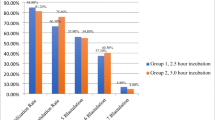Abstract
Purpose: Our purpose was to determine if controlled ovarian hyperstimulation adversely affects implantation.
Methods: A retrospective comparison of pregnancy rates (PRs) and implantation rates was made between oocyte recipients versus their donors, who shared half of the retrieved oocytes, and regular patients undergoing in vitro fertilization–embryo transfer (IVF-ET) who were not sharing eggs.
Results: Higher implantation rates (39.0 vs 22.5%; P < 0.05) were found in recipients compared to donors in the stimulated cycle. However, no differences were seen in PRs or implantation rates in frozen ET cycles. The data for standard IVF patients were almost-identical to those for donors.
Conclusions: Superior implantation rates and PRs in oocyte recipients versus donors were not related to better oocyte quality for recipients because of egg sharing or to a better uterine environment because of similar results with frozen ET in all three groups. An adverse effect of the hyperstimulation regimen best explains the difference.
Similar content being viewed by others
REFERENCES
Rosenwaks Z: Donor eggs: Their application in modern reproductive technologies. Fertil Steril 1987;47:895-909
Serhal PR, Craft LL: Ovum donation—A simplified approach. Fertil Steril 1987;48:265-269
Ben-Nun I, Ghetler Y, Gruber A, Jaffe R, Fejgin M: Egg donation in an in vitro fertilization program: An alternative approach to cycle synchronization and timing of embryo transfer. Fertil Steril 1989;52:683-687
Devroey P, Smith J, Camus M, Sisanto A, Deschacht J, Van Waesberghe L, Van Steirteghem AC: Synchronization of donor's and recipient's cycles with GnRH analogues in an oocyte donation program. Hum Reprod 1989;4:270-274
Frydman R, Letur-Konirsch H, de Ziegler D, Bydlowski M, Raoul-Duval A, Selva J: A protocol for satisfying the ethical issues raised by oocyte donation: the free, anonymous and fertile donors. Fertil Steril 1990;53:666-672
Check JH, O'Shaughnessy A, Lurie D, Fisher C, Adelson HG: Evaluation of the mechanism for higher pregnancy rates in donor oocyte recipients by comparison of fresh with frozen embryo transfer pregnancy rates in a shared oocyte programme. Hum Reprod 1995;10:3022-3027
Pie-Zeigler R, Shelton KE, Tone JP: Salpingectomy(ies) improves the pregnancy rate after IVF in patients with unilateral or bilateral hydrosalpinx. J Assist Reprod Genet 1995;12:S65
Shelton KE, Butier L, Toner JP: Salpingectomy improves the pregnancy rate in in vitro fertilization patients with hydrosalpinx. Hum Reprod 1996;11:523-525
Puttermans PJ, Brosens IA: Salpingectomy improves in vitro fertilization outcome in patients with a hydrosalpinx: Blind victimization of the fallopian tube? Hum Reprod 1996;11:2079-2081
Aubriot FX, Chapron C, Morice P, Dubuisson JB: Hydrosalpinx et sterilite: indications de la salpingectomie. Contracept Fertil Sex 1995;23:670-673
Andersen AN, Linhard A, Loft A, Ziebe S, Andersen CY: The infertile patient with hydrosalpinges: IVF with or without salpingectomy? Hum Reprod 1996;11:2081-2084
Dechaud H, Daures JP, Arnal F, Humeau C, Heden B: Does previous salpingectomy improve implantation and pregnancy rates in patients with severe tubal factor infertility who are undergoing in vitro fertilization? A pilot prospective randomized study. Fertil Steril 1998;69:1020-1025
Shelton KE, Butler L, Toner JP, Oehninger S, Muasher SJ: Salpingectomy improves the pregnancy rate in in-vitro fertilization patients with hydrosalpinx. Hum Reprod 1996;11:523-525
Check JH, Lurie D, Dietterich C, Callan C, Baker A: Adverse effect of a homogeneous hyperechogenic endometrial sonographic pattern, despite adequate endometrial thickness on pregnancy rates following in-vitro fertilization. Hum Reprod 1993;8:1293-1296
Mukherjee T, Copperman AB, McCaffrey C, Cook CA, Bustillo M, Obasaju M: Hydrosalpinx fluid has embryotoxic effects on murine embryogenesis: A case for prophylactic salpingectomy. Fertil Steril 1996;66:851-853
Paulson RJ, Sauer MV, Lobo RA: Embryo implantation after human in vitro fertilization: importance of endometrial receptivity. Fertil Steril 1990;53:870-874
Strandell A, Waldenstrom U, Nilsson L, Hamberger L: Hydrosalpinx reduces in vitro fertilization/embryo transfer pregnancy rate. Hum Reprod 1994;9:861-863
Blazar AS, Hogan JW, Seifer DB, Frishman GN, Wheeler CA, Haning RV: The impact of hydrosalpinx on successful pregnancy in tubal factor infertility treated by in vitro fertilization. Fertil Steril 1997;67:517-520
Vandromme J, Chasse E, Lejeune B, Van Rysselberge M, Selvigne A, Leroy F: Hydrosalpinges in in vitro fertilization: An unfavorable prognostic feature. Hum Reprod 1995;10:576-579
Andersen AN, Yue Z, Meng FJ, Petersen K: Low implantation rate after in vitro fertilization in patients with hydrosalpinges diagnosed by ultrasonography. Hum Reprod 1994;9:1935-1938
Fleming C, Hull MG: Impaired implantation after in vitro fertilization treatment associated with hydrosalpinx. Br J Obstet Gynaecol 1996;103:268-272
Meldrum DR: Female reproductive aging-ovarian and uterine factors. Fertil Steril 1993;59:1-5
Al-Khatib RA, Fakih H: Artificial hormonal replacement cycles have no advantage over hyperstimulated cycles in a gamete intrafallopian transfer oocyte donation program. Fertil Steril 1995;63:1255-1259
Author information
Authors and Affiliations
Rights and permissions
About this article
Cite this article
Check, J.H., Choe, J.K., Katsoff, D. et al. Controlled Ovarian Hyperstimulation Adversely Affects Implantation Following In Vitro Fertilization–Embryo Transfer. J Assist Reprod Genet 16, 416–420 (1999). https://doi.org/10.1023/A:1020565408018
Issue Date:
DOI: https://doi.org/10.1023/A:1020565408018




